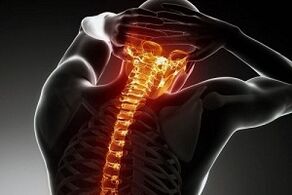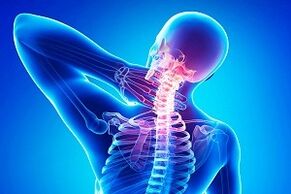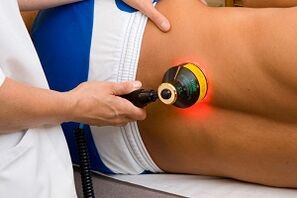
Osteochondrosis is a pathology of the spine that affects millions of people of all ages.
Degenerative and dystrophic changes in the intervertebral discs, proliferation of osteophytes cause pain syndrome, reduce the mobility of the supporting column. Symptoms depend on the affected area.
In most cases, the adverse effects not only affect the support column and paravertebral area, but also spread to other areas.
In the absence of treatment, the disease progresses, the functioning of organs and systems deteriorates, the health condition deteriorates significantly, and complications against the background of constant pain and pathology can lead to disability.
It is important to know what osteochondrosis is, the causes of a common disease, and ways to treat and prevent it.
Causes of the disease

Degenerative and dystrophic processes in the intervertebral discs, excessive ossification in the affected area develop in the following cases:
- back injuries;
- heavy work, professional sports, high loads on the support post during cargo transportation;
- congenital defects of the support column;
- vitamin, mineral deficiency, deterioration of pillow quality;
- disorders of mineral metabolism;
- hormonal disorders, endocrine diseases;
- inactivity, sedentary work;
- severe obesity;
- decrease in the elasticity of the intervertebral discs with aging in the elderly;
- excessive consumption of strong coffee, carbonated and alcoholic beverages, sour foods, smoked meats, cigarettes;
- tumor process in the paravertebral zone that damages the elastic structures of the spine.
Types and stages
Osteochondrosis affects all parts of the support column. Degenerative processes are more active in the mobile regions: in the lumbar and cervical, thoracic region, less damage to the vertebrae, bone tissue.
There are several types of osteochondrosis, depending on the affected area:
- cervical;
- chest;
- lumbosacral.
Pathological stages:
- The first stage- development of chondrosis. Lack of nutrients worsens the quality of the disc and reduces the elasticity of the pillowcase. Against the background of thinning of cartilage tissue, high loads cause mild to moderate pain in the spine;
- second stage.Deformations of elastic structures are more pronounced, pain is visible not only during loads, but also during bending and turning. Defeat of the annulus fibrosus leads to compression of sensitive structures, increased friction of bone elements;
- third stage.The integrity of the annulus fibrosus is compromised, the disc protrudes beyond the vertebrae, and the pain syndrome is pronounced. It is difficult for a patient to do this without medication to reduce anxiety. Against the background of the destruction of the elastic cushion, the mobility of the support column decreases, protrusions and intervertebral hernias develop;
- fourth stage.The cartilaginous layer is practically absent, osteophytes appear in the spine. Bone growth is an attempt to compensate for the excessive load on the affected vertebrae. Dense elements stabilize the spine, while reducing the mobility of the problem area of the support column. In the fourth stage of osteochondrosis, the pain subsides, but the patient has difficulty performing simple movements. If changes occur in the lumbosacral area, paresis or paralysis of the lower body may occur. Often, in the fourth stage of osteochondrosis, the patient becomes disabled.
Note!Supportive disease occurs with periods of remission (from a few months to a year or more) and exacerbations (the duration of the relapse, the severity of the pain depends on many factors).
The first signs and symptoms

The manifestation of the disease depends on the stage and the affected part.
The more negative factors, the higher the risk of pain syndrome and damage to other areas.
Circulation deteriorates, mineral metabolism is impaired, protrusions, vertebral hernias develop, excessive ossification occurs in the affected area.
Self-medication, lack of qualified care, and unwillingness to visit a vertebrologist from time to time have a negative impact on the condition of vertebral structures.
Cervical
The main symptoms are:
- radicular syndrome with severe disc damage;
- pain in the back of the head, neck, crown;
- dizziness, fainting;
- headache;
- discomfort in the muscles of the shoulder, neck;
- alignment of the cervical area, hands, fingers;
- discomfort in the chest area;
- impaired cervical spine mobility;
- decrease or loss of shoulder muscle reflexes;
- feeling of "gas bumps" on the hands, fingers;
- A person with cervical spine osteochondrosis is irritated against the background of insomnia, depressive states, unbearable or excruciating pain in the neck and head.
Chest osteochondrosis
Typical symptoms:
- heavy loads, twists, bends, chest pain appear when left in one position for a long time;
- with a deep breath, discomfort of varying intensity is felt in the middle of the back;
- pain increases when lifting arms, moving body;
- with the development of osteochondrosis of the thoracic region, there are problems with the digestive system;
- there is an unpleasant feeling of "gas bubbles" in the hands;
- Depending on the degree of damage, doctors prescribe dorsalgia - painful sensations in the affected spine and buttocks - acute, excruciating pain of high intensity, causing muscle spasms by restricting breathing;
- develops intercostal neuralgia;
- aching or sharp pain in the area of the shoulder blades;
- reproductive disorders occur.
Lumbosacral region

The main symptoms are:
- discomfort of varying intensity in the lumbar region;
- muscle weakness, development of paresis;
- coldness and numbness of the lower extremities;
- pain syndrome is expressed by heavy loads or lifting loads;
- painful lumbar lumbago appears: the pain spreads from the lower back to the gluteal zone, groin, legs;
- intermediate claudication develops;
- Compression of nerves adversely affects the work of the pelvic organs: severe lumbosacral osteochondrosis, urinary incontinence, involuntary defecation are possible;
- fatigue is visible, it is difficult to stand, long walks cause weakness in the legs.
Diagnostics
You should contact a vertebrologist to clarify the condition of the spine. If you do not have a doctor in this specialty, you should consult a neurologist or orthopedic traumatologist.
Diagnostic measures:
- Examination of the patient, investigation of complaints.
- MRI.
- CT.
- X-ray of the spine in several projections.
- Doppler ultrasound examination of blood vessels.
- Electromyography.
Effective treatments
How to treat osteochondrosis? Chronic pathology requires attention from both the doctor and the patient. Do not expect the negative symptoms to disappear one week after starting the course of therapy. Only an integrated approach works. The patient should understand that drugs alone can not eliminate the degenerative-dystrophic changes in the discs, prevent the proliferation of osteophytes.

It is important for the successful treatment and prevention of osteochondrosis:
- follow a combination of exercise therapy;
- to participate in massage and physiotherapy;
- Healthy food;
- to organize work and sleeping places taking into account the doctor's recommendations;
- do not lift weights;
- take vitamins and mineral complexes from time to time to maintain the elasticity of the discs, the strength of bone tissue;
- avoid strenuous exercise;
- avoid back injuries and bruises;
- control your weight.
There are other important rules:
- do not overcool;
- treat pathologies that adversely affect the condition of the discs;
- take a break while working on the computer, warm up;
- exercise more, exercise;
- avoid excessive coffee and alcohol consumption, forget about smoking;
- prevent long-term static / dynamic loads;
- sleep on an orthopedic mattress and low pillow;
- less nervous;
- set aside 7 hours for at least one night's sleep;
- Periodically visit a vertebrologist, monitor the condition of the spinal structures.
Medications
Effective groups and names:
- chondroprotectors. . . Restores cartilage tissue, slows down the process of disc destruction. Course - 4 months or more;
- NSAID. . . Medications relieve pain, swelling and inflammation. Local remedies have a good effect: ointments, gels, plasters;
- B vitamins. . . Medications restore nerve regulation, improve neuronal nutrition, and reduce the severity of pain syndrome. Injections (first days during inflammation) and tablets (for a long course of treatment and prevention) are effective;
- muscle relaxant. . . The remedies cope with muscle spasms, which are the main cause of nerve ending compression;
- compositions that normalize blood circulation.Often drugs of this group are prescribed for cervical osteochondrosis, in which the brain suffers;
- spinal obstruction, injection into the paravertebral zone. This type of exposure contributes to unbearable lumbago and pain in the background of compressed nerves in the third or fourth stage of osteochondrosis. Corticosteroids and excipients are added to analgesics to increase the effect;
- GCS drugs.Steroid formulas are important for severe pain. Injections are often prescribed for lumbosacral osteochondrosis, in which painful lumbago develops.
Training and gymnastics
Exercises for the cervical, lumbosacral and thoracic regions are prescribed after the elimination of acute pain, the weakening of the inflammatory process. For each zone, doctors have developed a complex of exercise therapy with varying degrees of stress.
The first sessions are conducted under the guidance of a physiotherapist. After learning the complex, the patient continues to train at home. It is important to observe the duration and frequency of sessions to achieve a therapeutic effect. In addition to physical training, vertebrologists recommend going to the pool: swimming is an ideal type that has a positive effect on the spine.
Physiotherapy procedures

Effective methods:
- ozokerite applications;
- laser therapy;
- radon and turpentine baths;
- shock wave therapy;
- electrical procedures;
- mud treatment;
- phonophoresis and electrophoresis with drugs;
- magnetotherapy.
The following methods are effective in the treatment of osteochondrosis:
- acupuncture;
- hirudotherapy;
- reflexology;
- using a needle applicator;
- hand therapy;
- dry and underwater spinal column laying;
- medical applicator.
It is very difficult to prevent the development of osteochondrosis, but doctors advise to remember the factors that cause dystrophic and degenerative processes in the vertebral structures. The more a person pays attention to a healthy lifestyle, the lower the risk of developing negative changes in the intervertebral discs.

















































